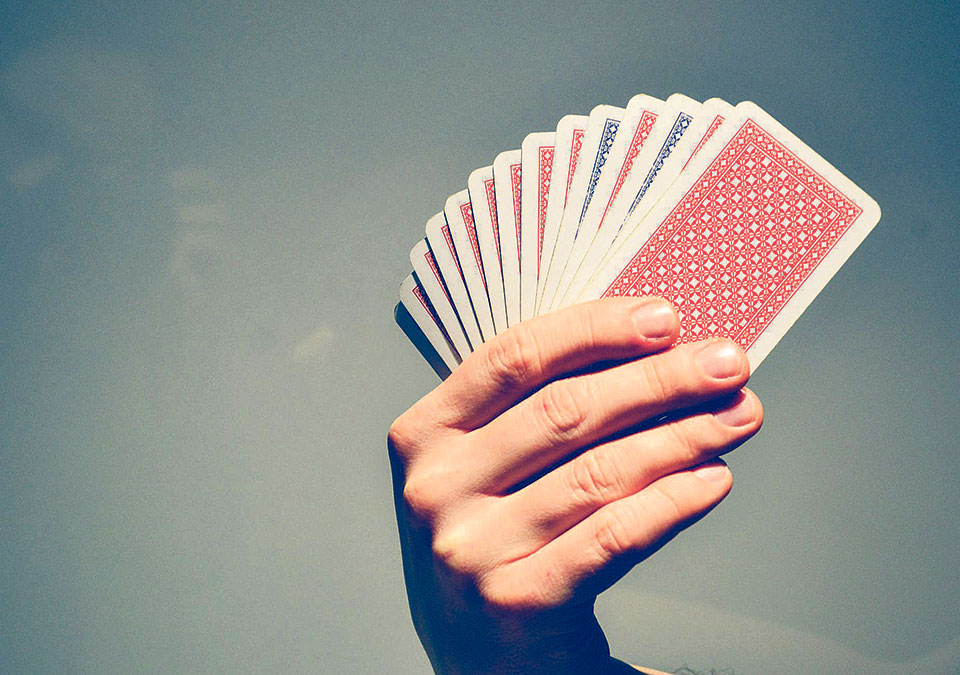
OR

A guide to some fun card games you can play this Dashain
Jhyap
The objective of this bizarre draw- and discard-game is to have the least total value of cards in your hand than other players. When you think you have accomplished this, you call “Jhyap” and compare hands. Each game consists of rounds, and each player’s total score is updated after each round. The aim of the game is to keep your score to a minimum. Players with more than an approved maximum, for example 100 points, leave the game, which is then continued until there is only one player left.
The basics
This game can be played by two or more players, with a 52-card deck with no jokers. Each card in the deck has a rate: Ace is worth 1, cards 2-10 are worth their face value, and pictures are worth 10.
The rules
Deal and play are counter-clockwise.
Any player may shuffle and deal the cards. Five cards are provided to each player, one at a time while face down. The remaining cards are positioned face down in the center to form a drawing stock. The top card of the pile is turned face up and put alongside it to start the “dump pile”.
The first player for the first round should be chosen beforehand since the first player has an advantage. In the following rounds, the winner of the previous round starts. The turn to play goes on clockwise around the table.
In your turn you are permitted to do one of two things: Throw one or more cards from hand to the dump pile and then pick one card up or call “Jhyap” to finish the play, if you think the sum value of your cards is less than that of any other player. Also, you cannot call “Jhyap” unless it’s your turn. If after discarding and picking up you think you have the lowest sum, you must wait for your next turn in order to end the game.
If the drawing deck is cleared and no one has finished, all the cards on the dump pile except for the last player’s discard are shuffled and put face down to start a fresh drawing deck.
29
This is a fun game that’s a little tricky but once you get the hang of it, there’s no end to all the fun you will have. Though it’s usually played by four players in pairs with the partners facing each other, two players can also play the game.
The basics
From a standard 52-card pack, 32 cards are used for play. There are eight cards in each of the usual suits: hearts, diamonds, clubs and spades. The cards in every suit rank in a descending order: J-9-A-10-K-Q-8-7. The objective of the game is to win tricks that consist of valuable cards.
There is total of 28 points for cards. In some editions of the game, the last trick is worth an extra point, for a total of 29: which explains the name of the game. Most players these days do not consider the point for the last trick, but the name of the game is still 29, even when playing this edition with 28 points.
The rules
Both deal and play are clockwise; the cards are cut by the player to the dealer’s right and shuffled by the dealer. Then, one at a time, four cards are dealt to each player.
Based on these four cards, players bid for the right to decide trumps. Each bid is a number, and the highest bidder assumes that his or her side will triumph in tricks at least the number of points bid. The player to the dealer’s left speaks first, and following players, in clockwise order, may either bid higher or pass. The minimum bid accepted is 15 and the maximum is 28 (presuming that the point for the last trick is not considered). If any player bids, the auction proceeds for as many rounds as needed until three players pass in sequence. If the first three players pass, the dealer is obligated to bid 15, which ends the auction.
The last bidder chooses a trump suit and to point out the chosen suit, arranges the face down stack of twos to fives that have not used in the play so that a card of the chosen suit is at the bottom, but does not allow other plays to see this card. The dealer then finishes the deal, giving four more cards to each player, so that all players have eight respectively.
The player to the dealer’s left directs to the first trick; players are required to follow suit if possible, and the winner of each trick leads to the following. At first the trump suit is unknown to the players other than the bidder. The foremost player who is unable to follow suit is obliged to ask the bidder to affirm the trump suit. The bidder then reveals the trump indicator card to everyone. If the bidder is the first player to not be able to follow suit, he must announce what suit trumps at that point. A player unable to follow suit can play any card; there is no compulsion to play a trump. Starting from the trick during which the trump suit is announced, each trick is won by the highest trump in it, or by the highest card of the suit led if it holds no trumps.
At any time after the trump has been affirmed, a player who holds both the King and Queen of trumps in hand can declare them as soon as he/her or his/her partner has won a trick. If the pair is affirmed by the bidder or the bidder’s partner, the effect is to decrease by four the number of card points they need to achieve their bid, subject to a minimum of 15; if an opponent of the bidder declares a pair, it adds to the number of points required by the bidding side by four, subject to a maximum of 28 (presuming there is no point for the last trick).
After all eight tricks have been used, each side calculates the card points in the tricks it has won, the winners of the last trick adding an additional card point. The game is won by the first team to attain a collective score of plus six game points. It can also end if a team gets to minus six game points.
Flush
Teen Patti, means “three cards”, and is also known as Flush (or Flash). An international 52-card pack is used.
The rules
Before beginning the game, it is essential to be in agreement of the value of the minimum stake. Everyone places this minimum stake in the pot – a collection of money in the middle of the table, which will be won by one of the players. The dealer deals out the cards until everyone has three cards, one at a time. Then, the players gamble on who has the best three card in hand. Each has the choice to look at their three-card hand before betting (playing seen) or to leave their cards face down on the table (playing blind).
The betting begins with the player on the left of the dealer, and continues with players taking turns in clockwise order for as many circuits as are needed. In turn, each player can either place an additional bet into the pot to continue playing in the game, or pay no further and fold. While folding, you permanently leave the betting and forfeit any money you have previously put into the pot during that deal.
The amount that you have to put in at your turn in order to continue playing in the game depends on the “current stake”, and whether you are playing blind or seen - seen players have to bet twice as much as blind players to stay in the game.
If you are a blind player, meaning that you have not yet seen your cards, you are obliged to put in at least the existing stake and not more than twice this stake. If you are a seen
player you are required to bet at least twice the existing stake and not more than four times this stake.
The betting proceeds in this way until all except one player have folded. In that case the last player wins all the money in the pot, regardless of the cards held or all except two players have folded and one of these players at their turn pays for a show. In that case, the cards of both players are shown and compared.
You May Like This

Dashain over but Dashain tika continues
KATHMANDU, Oct 12: People continued to visit their relatives and family members, receiving Dashain tika, jamara and blessings today also,... Read More...

Voter card printing to begin April 2, 14m voters to get IDs
KATHMANDU, March 30: The Election Commission (EC) will start printing voter identity cards from April 2 in a bid to conduct... Read More...

Huawei launches Dashain scheme
KATHMANDU, Sept 8: Huawei Consumer Business Group has announced the launch of its Dashain scheme – Prize Ek-sa- Ek, Yo Dashain... Read More...





Just In
- Clash erupts between police and agitating locals in Dhanusha, nine tear gas shells fired
- Abducted Mishra rescued after eight hours, six arrested
- Forest fire destroys 13 houses in Khotang
- First meeting of Nepal-China aid projects concludes
- Lungeli appointed as Minister for Labor and Transport in Madhesh province govt
- Bus knocks down a pilgrim to death in Chitwan
- One killed in tractor-hit
- Karnali Chief Minister Kandel to seek vote of confidence today














Leave A Comment